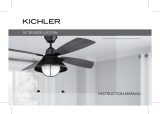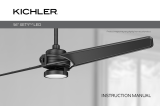
52" Compass LED | 3
SAFETY RULES
READ AND SAVE THESE INSTRUCTIONS
CAUTION CAUTION – RISK OF SHOCK –
Disconnect Power at the main circuit breaker panel or
main fuse box before starting and during the installation.
WARNING: WARNING: This fixture is intended for installation in
accordance with the National Electrical Code (NEC) and
all local code specifications. If you are not familiar with
code requirements, installation by a certified electrician is
recommended.
WARING: WARING: To reduce the risk of fire or electric shock, use
only the control provided with the fan.
WARNING: WARNING: To reduce the risk of fire, electric shock, or
Personal Injury, mount directly to a structural framing
member or to an outlet box marked “Acceptable For
Fan Support of 15.9kg(35 lbs) or less”. For outlet box
mounting, use mounting screws provided with the outlet
box.
WARNING:WARNING: Do not operate reversing switch while fan
blades are in motion. Fan must be turned off and blades
stopped before reversing blade direction.
Avoid placing objects in the path of the blades.
To avoid personal injury or damage to the fan and other
items, be cautions when working around or cleaning the
fan.
1.
2.
3.
4.
5.
6.
7.
8.
9.
10.
11.
Make sure the installation site you choose allows a
minimum clearance of 7 feet from the blades to the floor
and at least 30 inches from the ends of the blades to any
obstruction.
Do not use water or detergents when cleaning the fan or
fan blades. A dry dust cloth or lightly dampened cloth will
be suitable for most cleaning.
After making the electrical connections, spliced
conductors should be turned upward and pushed carefully
up into outlet box. The wires should spread apart with the
ground wire and white(common) wire to one side with the
black (load) wire to the other side of the outlet box.
Electrical diagrams are for reference only. Light kits that
are not packed with fan must be ETL Listed and marked
suitable for use with the model fan you are installing.
Switches must be ETL General Use Switches. Refer to the
instructions packaged with the light kits and switches for
proper assembly.
WARNING
TO REDUCE THE RISK OF PERSONAL INJURY. DO NOT
BEND THE BLADES DURING ASSEMBLY OR AFTER
INSTALLATION. DO NOT INSERT OBJECTS IN THE PATH
OF THE BLADES.























